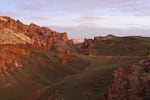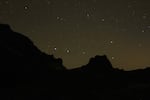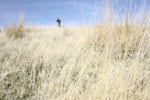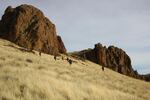
Residents and conservationists disagree over what should be done to protect the Owyhee region in southeastern Oregon.
Amanda Peacher / OPB
On a rainy fall day, a group of bundled up hikers explored Leslie Gulch. Kirk Richardson, with Keen Footwear in Portland, pointed to a bulbous rock formation jutting from the canyon wall.
"I like this one that’s kind of a split molar root," Richardson said. "Looks like something you’d see in a dentist X-ray."
The volcanic formations in this remote canyon in Southeast Oregon are similar to what you might find in southern Utah, or at Oregon’s Smith Rock -- but even more vivid. The Owyhee’s red rock towers look like they’ve been glazed with maple syrup.
“Leslie Gulch is so gorgeous," said Richardson, gazing up at the sheer rock walls. "It's sort of Smith Rocks on steroids.”
Richardson is part of the Owyhee Coalition, a group of conservationists who want federal protections for this area. The leader of this hike, Corie Harlan is with the Oregon Natural Desert Association, or ONDA. The desert association wants to designate 2.5 million acres of the Owyhee as a national conservation area and wilderness. That's more than three percent of Oregon's land mass, or about the size of Yellowstone National Park.
Many local residents oppose conservation designations.
Harlan led the group down a sandy trail in a small side canyon called Dago Gulch. The brush and soil were wet from morning rain, and the air was full with the scent of sage. She ran her hand along the thin branch of a brush plant. "It's fresh, and spicy and amazing," she said. Harlan said a wilderness designation would still allow grazing and road access, but would protect the area from new industry -- like oil and gas drilling.
“This place will not stay the way it is," said Harlan. "Development is coming, it’s clawing at the edges.”
A National Monument For The Owyhee?
There's also another conservation proposal: Designating an Owyhee National Monument, that could be created with the stroke of a pen by President Obama, through the Antiquities Act.
And that’s the reason for the sense of urgency many felt in the crowded Adrian High School Gym on Oct. 29. People came from across Eastern Oregon to attend a public meeting about the Owyhee’s future.
The Oregon Natural Desert Association has been talking about wilderness for years, but that can only happen through Congress. Obama has already created or expanded 19 national monuments. Now, the very real prospect of a Democratic president designating a monument in the Owyhee has galvanized local residents.
The overwhelming majority of local residents who spoke up at the October meeting were adamantly against a monument. Judy Wilcox said ranchers like her are already protecting the landscape, through efforts to restore sage grouse populations.
Related: US Rejects Protections For Greater Sage Grouse
“We don’t need more government in Malheur County. The landowners, the ranchers, the agricultural community, we want to do this on our own,” Wilcox said.
There were more than 500 people in the room, more than triple the number who live in Adrian, population 170.
Keen Footwear executive Richardson came from Portland to speak in support of the monument.
"I think one of the things that people in this room may or may not understand, is the strength of the outdoor industry," Richardson said, adding that hikers and rafters could be an economic boon to Malheur County, the poorest county in Oregon.
Greg Jones didn’t buy that.
"We here in Malheur County have a great love and appreciation for having the Portlanders tell us what we need to do and how we need to do it," Jones said, with sarcasm. "You’re on vacation, you come here to enjoy it, you come here on your off time. We live here. We have lived here, died here, bled here. We love that country just as much as you do. But we have a vested interest."
Residents feel that people who live in urban areas see the Owyhee as a playground.
For one thing, people who live here are worried about federal designations affecting cattle grazing — which is a major part of the economy here. And they feel outnumbered by urban conservationists.
Harlan, from the Oregon Natural Desert Association, said traditional uses of the site, like grazing, can continue with federal protections.
"The Owyhee is an Oregon treasure, it's public lands that belong to all of us," Harlan said. "So while it is absolutely important that local people have a voice, it's also just as important that everyone in the state has a voice. It's that special."
In November, Harlan led a journey back to the Owyhee, a scouting trip with Basecamp Brewery. The Portland-based company plans to create a beer in honor of the Owyhee, and Harlan designed the expedition to introduce the brewers to the landscape. Part of the Oregon Natural Desert Association's conservation strategy is garnering business support across the state.
In the morning, Harlan guided campers over the grass-covered ridge lines above the canyons near Leslie Gulch, pointing out game trails. The Owyhee is home to one of the nation's largest herds of California bighorn sheep.
The only sign of development was a gravel road and a radio tower in the distance. The group passed piles of wild horse dung as they pushed through cheatgrass and sagebrush.
"So, when exactly is rattlesnake season?" asked Nancy Calhoun from Portland. Harlan assured her the snakes were sleeping.
Calhoun was taken with the Owyhee.
"I’m pretty impressed. I love the high desert but this is different than most high desert I’ve been to." Calhoun said. "It’s got this rolling plateau top. The canyon is sort of unexpected."
Before she came on this trip, Calhoun said she knew next to nothing about the Owhyee.
In that, Calhoun is like most Oregonians. You don’t just stumble on this place. It’s remote and it’s wild. Some don’t want to draw attention to the area for just those reasons.
“I’m more worried about the people that this could bring in," said Bob Skinner, who has a ranch outside of Jordan Valley, a tiny community on the Idaho/Oregon border. His sons and grandkids help run the ranch. There’s no cell service, so they communicate with handheld radios on the wide expanse of acres that is the family property. Kittens scurry around fenced fields with hundreds of brawling calves and rust-colored bulls.
Skinner opposes any federal designation for the Owyhee.
"The stuff about protecting it, I don’t believe that," he said. "It’s protected right now by it’s own geography. It’s huge, it’s isolated."
He’s worried about an influx of visitors in cars that could wear down the roads, or hikers getting lost and needing search and rescue.
He said he doesn’t think a wilderness proposal could get through Congress, because of local opposition. But he worried about President Obama designating the Owyhee a national monument.
“We’ve got a president that doesn’t seem to listen to the local people. I kind of feel helpless to tell you the truth," Skinner said.
Skinner’s two youngest grandkids played near one of the sheds. They looked around four or five years old, and the little boy wore a firefighter hat.
"Those are my youngest grandkids." He was getting ready to take them to a football game. His grandkids are the seventh generation in this family of ranchers. Skinner said he wants them to be able to have the same kind of experience of this place that he grew up with.
"The people that live here all love it here. We don't want to see it degraded, we don't want to see it change," he said.
And that's where Skinner and conservationists agree. They all want to protect the Owyhee from change. They just disagree on the best way.




